Atmospheric Pipes project
Introduction
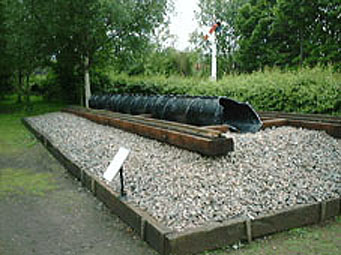
R J Heron
In an interesting parallel to the actions of the Great Western Railway itself, some 90 years earlier, the Bristol Group has undertaken a project to conserve and display three lengths of original pipe from Brunel's pioneering scheme of atmospheric propulsion on the South Devon Railway in 1847.
This project was completed in May 2000.
History
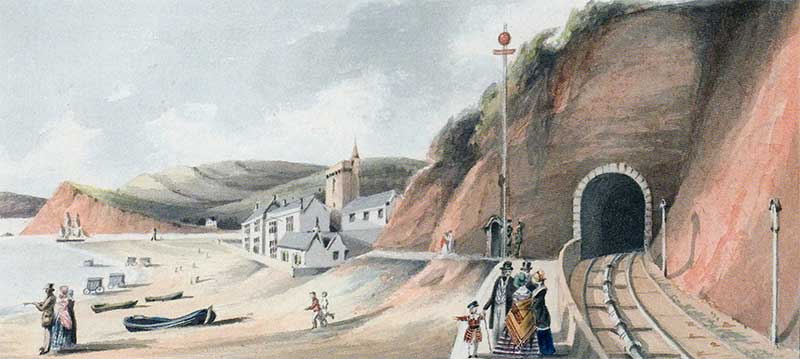
Isambard Kingdom Brunel, as engineer to the South Devon Railway, decided to adopt Clegg and Samuda’s patent system of atmospheric traction for the line from Exeter to Plymouth. This consisted of stationary pumping engines creating a partial vacuum in large slotted cast iron pipes laid between the rails. The pipe was sealed by airtight valves at each end and a metal strip hinged by leather along the length of the slot. The partial vacuum allowed a piston attached to a carriage to be propelled by the greater pressure of the atmosphere behind.
This system was intended to be much cleaner than traditional steam locomotives, virtually silent in operation, and capable of operating trains on much steeper gradients and sharper curves than steam locomotives could manage.
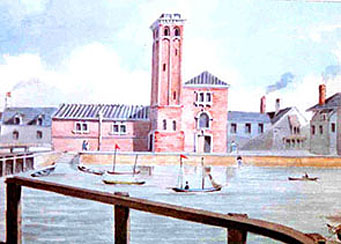
The largely flat section of the South Devon Railway between Exeter and Newton including the scenic seawall section through Dawlish, was duly built with 15” pipes for atmospheric operation, experimental services beginning in September 1847 and full atmospheric operation commencing in February 1848. Larger 22” pipes were purchased for the steeply graded section between Newton and Totnes where the increased diameter would be required for greater tractive effort. However as this section was being built it was becoming clear that there were many problems with the atmospheric section already laid. The leather hinges were not adequate for the task and large numbers of men were employed applying sealant to it. Even this was inadequate and air constantly leaked into the pipes making the already undersized stationary pumps work harder. Atmospheric working between Exeter and Newton was discontinued as from 10th September 1848 (after only 7 months). The Newton to Totnes section for which these 22” pipes were intended was never opened for atmospheric traction.
The cast iron pipes were removed and the pumping stations demolished or adapted to new uses but the steep grades and sharp curves of this part of the line have remained, as a legacy of ‘Brunel’s Atmospheric Caper’, to provide a challenge to Great Western locomotives and their successors as they struggle to lift their heavy trains over the South Devon banks.

The historic nature of the enterprise was not, however, wasted by the Great Western Railway's publicity machine.
The Great Western Railway Magazine for May 1912 (Vol 24 pp.137-140) featured an article by FC Warren about the South Devon Railway, and its engineering achievements in particular. Much praise was heaped upon the engineering behind the seawall section, and the various viaducts and tunnels. Naturally some space in the article was devoted to the atmospheric system, and part of this included the photograph below left with the caption ‘Atmospheric Pipes, now used as a Surface Water Drain at Paignton’.
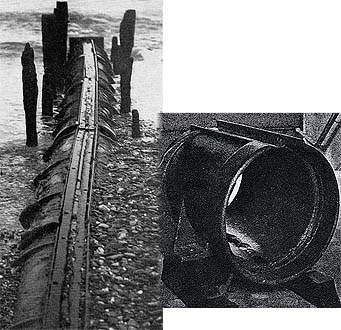
It is interesting to note that the 'slot' along the top of the pipes is here blocked by the use of equally outmoded bridge-rail. This apparently aroused some official interest, for in the Magazine for the following year (Vol 25 p.97) it was reported that the Board of Education ... ‘in co-operation with the Company’ had recovered portions of the pipe and transferred them to London. One section, as illustrated below, was placed in the Company's museum at Paddington, and there was also talk of using some of the material to set up ‘a model of the atmospheric system in the Science Museum at South Kensington’.
It seems that the Science Museum project was never carried out, presumably due to the intervention of WW1. However a a full 10ft long section of pipe which was intended for this project, and which was once displayed at the now-defunct Atmospheric Railway Museum at Starcross, remains in the care of the Science Museum, in store at the National Railway Museum in York.
Also at York, but this time on display in the NRM's 'Warehouse' section, is a mounted and captioned thin section of pipe.
The short length illustrated is probably the one which was kept by the GWR for its own museum at Paddington, and is now on display at 'STEAM - The museum of the Great Western Railway', at Swindon.
(See also TNA RAIL 1005/138)
The Project
So things remained until, in 1993, members of the South West Group of the Great Western Society spotted something unusual about some land-drainage pipes being removed at the top of Goodrington Sands beach. Surely a slot along the top of a drainage pipe was unusual ? Further investigations showed that this was indeed a quantity of original 22" diameter atmospheric pipe, and negotiations quickly resulted in the acquisition of three 10ft lengths for the Society (GWS NN 217)
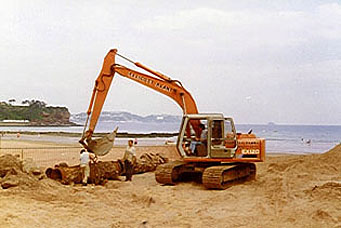
The pipes were transported to Didcot Railway Centre, where the years of accumulated, and very smelly, sludge was removed from the pipes by members of the South West and Bristol Groups of the Society.

With the majority of the sludge removed the pipes were immersed for a period of years in a special solution designed to remove the salt from the cast iron, to prevent their further deterioration. This was achieved using a bath constructed in an inspection pit on one of Didcot Railway Centre's turntable roads. When this process was completed the pipes were lifted out using the Society's 5-ton Steam Crane. The pipes were then painted with specialist rust-proofing paints.
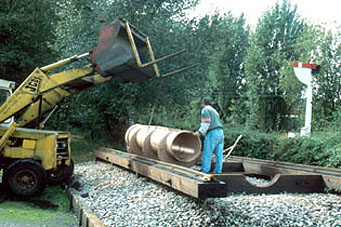
The Bristol Group undertook the on-site work to preserve and display the pipes. In addition to painting the pipes themselves, this involved the construction of a short length of trackbed reminiscent of the steepest (1 in 36) sections of Dainton Bank. On this foundation, a 35ft length of baulk road consisting of timber baulk and transoms held together by appropriate replica ironwork and carrying lengths of original bridge rail was erected and the atmospheric pipes themselves lifted into place by JCB and suitably painted.
This project was completed in May 2000 and the result can be seen at the North end of the site adjacent to the Broad Gauge running line.
Bibliography
|
Hadfield, Charles. 1967. Atmospheric Railways; A Victorian Venture in Silent Speed. |
|
Vaughan, Adrian. 1991. Isambard Kingdom Brunel: Engineering Knight Errant. John Murray, 50 Albemarle Street, London W1X 4BD. ISBN 0 7195 4636 2. |
| Various editions of the Great Western Railway Magazine |
In addition, various copies of the Great Western Echo (GW Echo), Great Western Society National Newsletter (GWS NN) both published by the Great Western Society, have been consulted.
Original Documentation has been consulted at The National Archives at Kew (TNA).
With thanks also to:
- Mr David Wright, (Curator, Collections, National Railway Museum, York)
for his assistance with research, and the provision of photographs.
